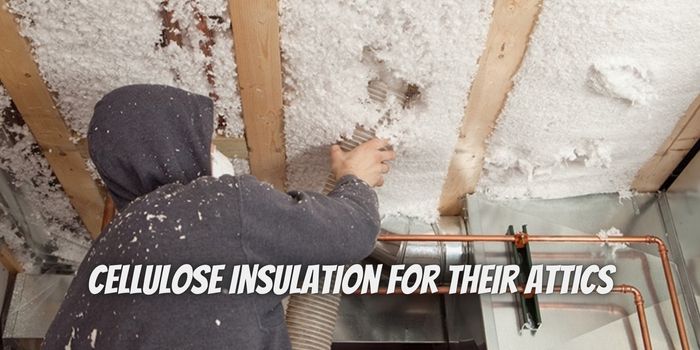Home insulation is an excellent way to save money on energy bills. Irrespective of the material used, insulation blocks raft air, ensuring that the indoor space has limited exchange with the outdoor. As more homeowners look to save money on energy costs, blown-in cellulose attic insulation has become increasingly popular.
An experienced roof repair specialist notes that blown-in cellulose insulation is made from fire-retardant components and recycled papers. The cellulose component forms a tight bond, providing excellent protection during extreme weather.
But why are more homeowners choosing cellulose insulations, and should you do the same? Find out the benefits of this insulation material below.
Benefits of Cellulose Attic Insulation
They’re Durable
Attic insulation is one of the excellent ways to keep your indoor space comfortable. However, homeowners should consider the durability of their insulation material choice before installing them.
Cellulose attic insulations offer proven durability and are quite efficient in blocking raft air. Unlike fiberglass, which may rot over time, cellulose insulations stand a better chance against roof leaks. They are also protected from fungus and mold growth, which can significantly improve the home’s indoor air quality.
If you’re looking for a durable and efficient attic insulation material with the fear of mold or fungus growth, you’re better off with cellulose. Another added advantage is its non-corrosive properties, making it perfect for all roofing materials and types.
Health and Safety Considerations
Insulation materials like asbestos has been found to be harmful to human health. Many cancer cases and other respiratory-related issues have been traced to asbestos deposits in the lungs. Other insulation materials may also cause skin irritation, nose and throat soreness, rashes, stomach irritation, redness of the eyes, nausea, etc.
However, cellulose insulation is free from these threats and risks. Homeowners can expect to avoid health and safety issues associated with other insulation materials by choosing cellulose.
Energy Efficiency
The main reason for insulating your property is to improve its energy efficiency and cut energy costs. Cellulose insulation helps to achieve this desired outcome. The material adheres strictly to the attic surface, blocking holes and cracks, and ensuring improved indoor comfort.
Environmentally Friendly
Cellulose insulation is made from recycled materials which makes it environmentally friendly. The insulation material helps reduce landfill waste while also offering improved energy protection to homes and buildings.
In addition, cellulose insulation requires less energy for its production and does not cause pollution. This makes it a perfect choice for homes and businesses looking to reduce their carbon footprint and environmental impact.
Comparing Blown Fiberglass vs. Cellulose Attic Insulation
Homeowners with blown fiberglass insulations installed may wonder how their current insulation material stacks up against cellulose. Find out the pros and cons of each material to make an informed decision.
Pros of Cellulose Insulation Over Blown Fiberglass
- Cellulose insulation is less of a health risk compared to fiberglass.
- Cellulose insulation is environmentally friendly as it is made from paper waste and recycled paper.
- Cellulose insulation is fire-resistant, insect-repellant, and doesn’t support mold growth
- Cellulose insulation is durable and maintains R-value for longer when treated with acrylic binders
- Cellulose insulation has a higher R-value of between R-3.2 to R-2.2 per inch.
Cons of Cellulose Insulation
- Installation cost is often higher compared to fiberglass insulation. However, homeowners can recover the added cost from its durability, cost-effectiveness, and energy efficiency.
- Cellulose insulation often creates a cloud of dust during the installation process. Installers should wear appropriate respiratory gear to protect their health.
Frequently Asked Questions About Cellulose Insulation
Does Cellulose Insulation Break Down?
Cellulose insulations are highly durable with a lifespan of between 20 to 30 years, depending on various conditions. During this period, they deliver great energy efficiency and provide air-blocking properties. The environmentally friendly insulation material can be easily replaced once it shows signs of deterioration or breakdown.
Is Cellulose Attic Insulation Safe?
Most roofing specialists consider cellulose attic insulation to be a safer choice than other materials like asbestos and blown fiberglass. The safety rating for cellulose insulation increases because it contains tightly packed fibers that can be made fire resistant when treated with boric acid.
What Can I Expect After Installing Cellulose Attic Insulation?
Cellulose attic insulation is an environmentally friendly choice for homeowners looking to reduce their carbon footprint. The material, when treated with boric acid, is also fire resistant, which contributes to safety in the home. Cellulose insulations are also generally resistant to mold, fungi, and insect attacks. Treating it with acrylic binders can also help to get the best insulation properties out of it.
Homeowners looking to replace their existing insulation may find cellulose insulation to be a perfect choice, especially because of its durability, R-value, and resistance to fires, mold, and mildew.
